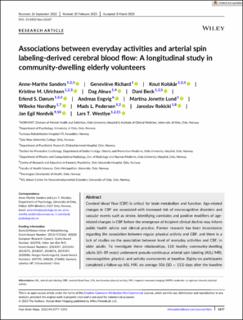Associations between everyday activities and arterial spin labeling-derived cerebral blood flow: A longitudinal study in community-dwelling elderly volunteers
Sanders, Anne-Marthe; Richard, Geneviève; Kolskår, Knut-Kristian; Ulrichsen, Kristine Moe; Alnæs, Dag; Beck, Dani; Dørum, Erlend Solberg; Engvig, Andreas; Lund, Martina Jonette; Nordhøy, Wibeke; Pedersen, Mads Lund; Rokicki, Jaroslav; Nordvik, Jan Egil; Westlye, Lars Tjelta
Peer reviewed, Journal article
Published version
Permanent lenke
https://hdl.handle.net/11250/3093998Utgivelsesdato
2023Metadata
Vis full innførselSamlinger
Sammendrag
Cerebral blood flow (CBF) is critical for brain metabolism and function. Age-related
changes in CBF are associated with increased risk of neurocognitive disorders and
vascular events such as stroke. Identifying correlates and positive modifiers of age-
related changes in CBF before the emergence of incipient clinical decline may inform
public health advice and clinical practice. Former research has been inconclusive
regarding the association between regular physical activity and CBF, and there is a
lack of studies on the association between level of everyday activities and CBF, in
older adults. To investigate these relationships, 118 healthy community-dwelling
adults (65–89 years) underwent pseudo-continuous arterial spin labeling (ASL) MRI,
neurocognitive, physical, and activity assessments at baseline. Eighty-six participants
completed a follow-up ASL MRI, on average 506 (SD = 113) days after the baseline scan. Cross-sectional analysis revealed credible evidence for positive associations
between time spent on low intensity physical activity and CBF in multiple cortical
and subcortical regions, time spent on moderate to vigorous intensity physical activity
and accumbens CBF, participation in social activity and CBF in multiple cortical
regions, and between reading and thalamic CBF, indicating higher regional CBF in
more active adults. Longitudinal analysis revealed anecdotal evidence for an interac-
tion between time and baseline level of gardening on occipital and parietal CBF, and
baseline reading on pallidum CBF, indicating more change in CBF in adults with lower
level of activity. The findings support that malleable lifestyle factors contribute to
healthy brain aging, with relevance for public health guidelines.

